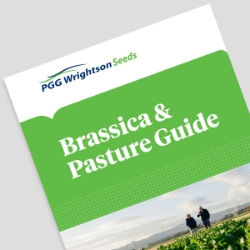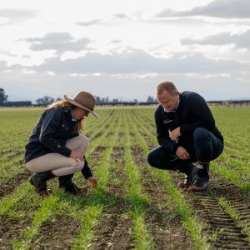Pasture renewal and cropping
PGG Wrightson Seeds programme approach to pasture renewal
Brassica forage crops, while being an excellent source of high quality and quantity feed to cover feed deficits and improve animal productivity, are also a logical part of a pasture renewal programme. Using a brassica crop is an integral part of a systematic approach to pasture renewal that PGG Wrightson Seeds has developed called the PROGRAMMED APPROACH™. The PROGRAMMED APPROACH™ encourages the view that grass is a crop and by treating pastures as a crop, farmers ensure they have a good supply of quality feed all year round.
The PROGRAMMED APPROACH™ to pasture renewal allows a farmer to capture the full value of improved pasture genetics available in today's new grass and clover.
BENEFITS OF THE PROGRAMMED APPROACH
- Opportunity to break the perennial weed cycle using glyphosate, leading to pastures free of couch, Californian thistle etc.
- Opportunity to break the clover pest cycle (e.g. Clover Root Weevil and nematodes), leading to better clover establishment and production.
- Opportunity to break the wild endophyte cycle to allow summer-safe grazing with introduced novel endophytes.
- Encourages forward planning and the opportunity to address fertility and drainage issues earlier, resulting in more productive pastures and crops.
- Increases the success of no-tillage/direct drilled systems.
AUTUMN YEAR ONE
After grazing the crop leave it fallow for a few weeks.
Reason:
This is to allow any residual perennial weeds to develop ready for spraying, and to allow soil moisture to build up.
Spray with glyphosate to control all established perennial and annual weeds.
Reason:
This is the last chance to clean up these weeds prior to going into a perennial pasture.
Direct-drill a high performing perennial pasture that includes a novel endophyte.
Reason:
The break provided by the crop, greatly reduces the incidence of nematodes, Clover Root Weevil, wild ryegrass endophytes and perennial weeds. Now is the time to introduce new technology grasses and clovers.
Sow BASE tetraploid perennial ryegrass + LEGACY white clover. Add Puna II chicory if thistles and Ragwort aren’t a problem.
Always sow new grasses with fertiliser, broadcast nitrogen at 30-40 kg/ha (Urea at 65-85 kg/ha).
Reason:
It should be assumed that the Brassica crop has removed significant N, P, K and S, which needs to be replaced.
AUTUMN YEAR TWO
After grazing the crop leave it fallow for a few weeks.
Reason:
This is to allow any residual perennial weeds to develop ready for spraying, and to allow soil moisture to build up.
Spray with glyphosate to control all established perennial and annual weeds.
Reason:
This is the last chance to clean up these weeds prior to going into a perennial pasture.
Direct-drill a high performing perennial pasture that includes a novel endophyte.
Reason:
The break provided by the crop, greatly reduces the incidence of nematodes, Clover Root Weevil, wild ryegrass endophytes and perennial weeds. Now is the time to introduce new technology grasses and clovers.
Sow BASE tetraploid perennial ryegrass + LEGACY white clover. Add Puna II chicory if thistles and Ragwort aren’t a problem.
Always sow new grasses with fertiliser, broadcast nitrogen at 30-40 kg/ha (Urea at 65-85 kg/ha).
Reason:
It should be assumed that the Brassica crop has removed significant N, P, K and S, which needs to be replaced.
LATE AUTUMN/EARLY WINTER - YEAR TWO
Graze quickly and lightly as soon as seedlings are firmly rooted.
Reason:
Large cows are okay, but ideally lighter stock classes (e.g. sheep or calves) should be used to lightly graze the new pasture. If using cows, pick a dry day and only graze for 2-3 hours to minimise "pulling" or "pugging".
Spray young grass 5-6 weeks after sowing to control germinating broadleaf weeds in the new pasture crop.
Reason:
Failure to put this spray on, is likely to result in potentially serious, long-term broadleaf weed competition in the new pasture: from docks, chickweed etc.
Continue to apply 30-40 kg Nitrogen / ha after each grazing.
Reason:
It will be 9-12 months before clover nitrogen fixation occurs.
SPRINT - YEAR ONE
Spray out the FEAST II™ or WINTER STAR® II with glyphosate plus an insecticide to prepare for the summer brassica crop.
Reason:
Include an insecticide that controls "springtails", a major pest of germinating brassicas.
Prepare a fine, FIRM clod-free seedbed and establish a summer crop of BARKANT™ turnips or GOLIATH® rape.
Reason:
The summer crop provides high quality summer feed, rich in energy. Substitution ensures pastures aren't over-grazed. The crop helps break the weed cycle and the pest cycle (nematodes and Clover Root Weevil) as well as remove wild endophyte from the paddoc
Manage the crop as per the BARKANT™ turnips or GOLIATH® rape best practice recommendations, applying good amounts of fertiliser and controlling weeds and pests.


